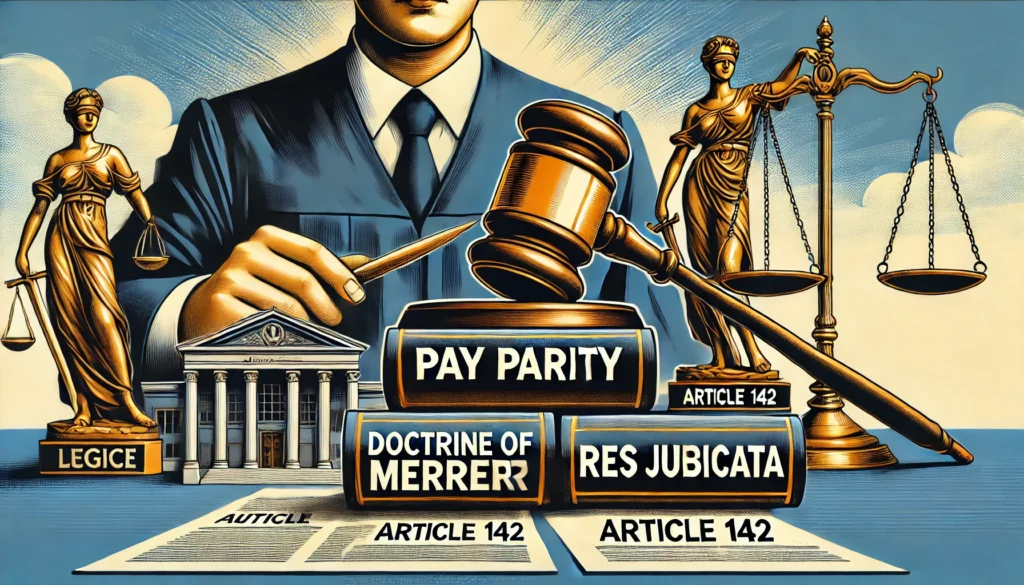
This article has been written by Anushree Jha, University of Mumbai, Thane Sub-Campus.

IN THE SUPREME COURT OF INDIA
CIVIL APPELLATE JURISDICTION
In Re: STATE OF UTTAR PRADESH AND ANR.’ ….Appellant(s)
V.
VIRENDRA BAHADUR KATHERIA AND ORS ….Respondent(s)
| NAME OF THE CASE | In Re: State of Uttar Pradesh & Anr. v. Virendra Bahadur Katheria & Ors. |
| CITATION | 2024 LiveLaw (SC) 480 & 2024 INSC 524 |
| COURT | Supreme Court of India |
| DATE OF JUDGEMENT | 15 July 2024 |
| APPELLANT | State of Uttar Pradesh and Another
|
| RESPONDENT | Virendra Bahadur Katheria and Others |
| BENCH/JUDGE | Hon’ble Justice Surya Kant and Hon’ble Justice K.V. Viswanathan |
| STATUTES INVOLVED | Constitution of India, Article 142
Uttar Pradesh Subordinate Educational (Sub Deputy Inspector of Schools) Service Rules, 1992 |
“Prescription of pay scale for a post entails a policy decision based upon the recommendations of an expert body like the Pay Commission. All that the State is obligated to ensure is that the pay structure of a promotional or higher post is not lower than the feeder cadre. Similarly, pay parity cannot be claimed as an indefeasible enforceable right save and except where the Competent Authority has taken a conscious decision to equate two posts notwithstanding their different nomenclature or distinct qualifications.”[1]
-Hon’ble Justice Surya Kant, Supreme Court of India
Abstract:-
This comprehensive case commentary aims to provide a concise overview of the facts in the matter of State of Uttar Pradesh & Anr. v. Virendra Bahadur Katheria & Ors, aiming to provide an analysis of the facts of the case, the various doctrines and legal provisions invoked as well as the issues presented in the case in this matter. This case, whose judgment is fairly recent, is a vital example of the apex court’s ability to juggle both the rights of employees in matters of disparity in remuneration and the state government’s valid concerns regarding financial burdens. Additionally, this judgment also sheds a keen lens on the applicability of the ‘Doctrine of Merger’ in the Indian legal context.
This case commentary seeks to provide a valuable source of knowledge for legal practitioners, law enthusiasts and students alike through a keen evaluation of the Supreme Court’s ruling and its consequences for public policy and administrative law through an objective lens.
Keywords:- Pay Parity, Doctrine of Merger, Res Judicata, Judicial Review, Article 142, Government Order
Overview of the Judgement:-
An ongoing issue of salary discrepancy within the Uttar Pradesh Education Department was addressed in this Supreme Court decision. A 2001 government order that changed the Headmasters’ pay rate and made them different from other administrative cadres like Sub-Deputy Inspectors (SDI), Assistant Basic Shiksha Adhikaris (ABSA), and Deputy Basic Shiksha Adhikaris (DBSA) was the root of the controversy.[2]
By combining these jobs into “Block Education Officers” and changing their compensation scale, the state made an effort to remedy the issue in 2011. However, there were issues with this ruling, especially in regard to the salary revision’s effective date and the arrears payment.
Recognizing the 22-year-old case, the Supreme Court carefully weighed the state’s financial burden against the employees’ justifiable complaints. In the end, the court upheld the 2011 order, which clarified the extent of its applicability and directed the payment of compensation.
The case demonstrates how difficult it is to address compensation discrepancies in government service. The court showed a balanced approach by taking into account both the employees’ valid claims and the state’s financial ramifications. The ruling offers important clarification on how the merger theory and res judicata principles should be applied in these situations.
Provisions and Doctrines Involved:-
The main legal theories and concepts at play in the case of Virendra Bahadur Katheria & Ors. vs. State of Uttar Pradesh & Anr. include the following:-
- Doctrine of Merger:- All earlier subordinate court rulings on the same issue “merge” into the Supreme Court’s ruling when it grants special leave and renders a conclusion. The case of Kunhayammed v. State of Kerala[3] (2000) established this premise. The Supreme Court’s 2010 ruling in this case superseded the High Court’s 2002 ruling.
- Res Judicata According to Section 11 of the Code of Civil Procedure, 1908, this legal doctrine forbids relitigation of cases that have previously been decided by a court of competent jurisdiction[4]. The High Court’s 2002 ruling was essentially incorporated into the 2010 Supreme Court ruling, therefore the Court made it clear that this principle did not apply in this particular case.
- Pay Parity:– Unless the positions are expressly judged similarly by appropriate authorities, the court reaffirmed that pay parity is not a fundamental right under Articles 14 and 16 of the Constitution. The precedent of State of U.P. v. J.P. Chaurasia (1989) backed this idea[5].
- Non-Recovery of additional payments:- The Apex court adopted the principle in the State of Punjab v. Rafique Masih (2015)[6], which forbids recovering extra payments from employees who have retired or are about to retire.
- Article 142 of the Indian Constitution:- This article gives the Supreme Court the authority to administer full justice in any case that comes before it[7]. The Court used this authority to strike a balance between the state’s financial burden and the interests of the employees.
- Judicial Review:- The Court emphasized that judicial review is restricted until fundamental rights are infringed, even as it emphasized the state’s role in formulating policies[8].
The various statutes and laws that apply in this judgment include:-
- The recruitment, compensation, and advancement of educational cadres in Uttar Pradesh are governed by the 1992 Subordinate Educational (Sub-Deputy Inspector of Schools) Service Rules[9].
- Constitutional Provisions such as:-
- Equality before the law (Article 14)
- Equality of opportunity in public employment (Article 16)
- Law Declared by the Supreme Court Binding on All (Article 141)
- Power of the Supreme Court to Do Complete Justice (Article 142)
- The Supreme Court is granted special leave to appeal (Article 136).
Facts of the Case:-
The Facts of the case are detailed below:-
- In 2001, the Government of Uttar Pradesh revised the pay scales of Headmasters of Junior High Schools through a government order. Their salary was greatly raised by this adjustment. However, the pay scales of Sub-Deputy Inspectors of Schools (SDIs), Assistant Basic Shiksha Adhikaris (ABSAs), and Deputy Basic Shiksha Adhikaris (DBSAs) were among the other administrative cadres in the education sector whose salaries had not changed. As a result, there was a notable pay gap because Headmasters, who had previously been beneath these cadres. Thus, headmasters were now paid more as a result of this order.
- The impacted authorities filed a lawsuit as a result of this pay discrepancy. The state was ordered by the Allahabad High Court in 2002 to provide SDI/ABSA and DBSA along with Headmasters with pay parity. The state contested this High Court ruling in the Supreme Court. The Supreme Court authorized a revised pay structure for the combined cadre of Block Education Officers (which included SDI/ABSA and DBSA) in 2010 after taking into account a state-proposed policy (recommendations from the Rizvi Committee). However, The 2011 Government Order that put this amendment into effect only allowed the implementation of this revision to apply after 2008.
- In order to obtain arrears from 2001 (the year of the first salary revision for Headmasters), the employees contested the 2011 order. Additionally, they were against recovering any overpayments that could have been unintentionally made as a result of the previous pay irregularities.
- The State of Uttar Pradesh contented that there must be adherence to the 2011 Order and the 2010 Supreme Court ruling, arguing that the state would be severely impacted financially by full retrospective arrears. They also made use of the merger theory, contending that the Supreme Court’s 2010 ruling superseded the High Court’s 2002 decree.
- On the other hand, the employees cited the initial High Court decision, and sought the arrears from 2001. They also refused to reimburse the state for any overpayments resulting from the prior pay discrepancy.
Issues Before the Court:-
The Core legal issues brought forward in this case include the following:-
- Retrospective Pay Scale Eligibility:- The main question was whether, in accordance with the 2011 Government Order, the SDI/ABSA and DBSA cadres were entitled to the updated pay scales starting in 2008 or as early as 2001, the year the pay structure for headmasters was changed. This required figuring out when the wage parity should be put into effect.
- Applicability of the Merger Doctrine:- Following the Supreme Court’s 2010 ruling, the Court had to decide whether the previous High Court ruling mandating wage parity for the SDI/ABSA and DBSA cadres was still legally binding. The main query was whether the merger doctrine (which holds that decisions from lower courts combine into the Supreme Court’s ruling after review) applied in this particular instance.
- Validity of Recovering Excess payments:- The Court had to determine whether the state had a right to recoup any overpayments given to the respondents as a result of the previous wage scale disparities. This required taking into account the idea that excess payments from retired or soon-to-be-retired personnel cannot be recovered.
In simple words, the Court had to deal with the central issues regarding the 2001 Government order’s legal ramifications and how it affected the various pay schedules of the different cadres. The Court was also required to determine the interaction between the Supreme Court’s later ruling and the High Court’s previous ruling. Additionally, it bore importance to also determine the possibility of recovering previous payments and the equitable factors in deciding when to adopt the updated pay scales.
Cases Referred:-
- Kunhayammed v. State of Kerala (2000) 6 SCC 359 which established the doctrine of merger.
- State of Punjab v. Rafique Masih (2015) 4 SCC 334 that barred recovery from retired employees.
- Supreme Court Employees’ Welfare Association v. Union of India (1989) 4 SCC 187 which discussed binding precedents under Article 141.
Judgement:-
The Uttar Pradesh Education Department had a long-standing wage inequality problem that was resolved by this Supreme Court ruling in this important judgement. The main conclusions of the court included the following:-
- Upholding of 2011 Government Order:- The Court upheld the 2011 Government Order, which combined the DBSA and SDI/ABSA cadres into the Block Education Officer cadre and updated their pay rates. Based on the suggestions made by the Rizvi Committee, this order was judged to be in line with the Supreme Court’s 2010 ruling.
- Limitation of Arrears:- The Court decided that contrary to what the respondents had originally requested, the updated pay scales and benefits would take effect in December 2008 rather than in 2001.
- Prohibition of Recovery:- Citing the non-recovery principle established in the State of Punjab v. Rafique Masih, the Court prohibited the recovery of excess payments made to retired or soon-to-retire employees.
- Application of the Doctrine of Merger:-The Court stressed that the 2002 High Court ruling was essentially rendered unenforceable by the 2010 Supreme Court ruling, which took precedence over it.
- Limited Scope of Judgment:- In order to avoid setting a precedent for other departments, the Court specifically restricted the application of its ruling to the particular cadres mentioned within the Education Department.
- Judicial Review and Policy Matters:- The Court stressed that unless there is an obvious infringement of fundamental rights, judicial action is limited and recognized the state’s role in setting wage scales.
Therefore, The key directions of the Supreme Court in the matter of State of Uttar Pradesh & Anr. v. Virendra Bahadur Katheria & Ors. included the following:-
- The Government Order from 2011 was upheld. Therefore, the respondents were to receive their arrears plus 7% annual interest within four months from the date of the order.
- The Supreme Court forbade the collection of extra money from retired workers.
- The ruling restricted its scope to the Education Department only.
Conclusion:-
In the matter of State of Uttar Pradesh & Anr. v. Virendra Bahadur Katheria & Ors., The Supreme Court displayed a very balanced and constitutional approach in this potent matter of pay disparity among employees in the public service, balancing both the rights of the employees as well as the financial responsibilities of the state of Uttar Pradesh. In its judgement, The Supreme Court deftly struck a compromise between the state’s budgetary limitations and the justifiable complaints of former workers. By the application of Article 142, The Court successfully applied its authority to settle the protracted dispute in a fair and reasonable manner while taking administrative effectiveness and governance principles into account. Additionally, The Court also managed to recognize the state’s budgetary reality while also prioritizing equity for retired employees by outlawing the recovery of surplus compensation from them.
[1] State of Uttar Pradesh v. Virendra Bahadur Katheria, (Page 28, ¶ 53) 2024 INSC 524
[2] State of Uttar Pradesh & Anr. v. Virendra Bahadur Katheria, Supreme Court Judgment, SUPREME TODAY (last visited Jan. 24, 2025), https://supremetoday.ai/doc/news/IND_SC_2024_INSC_524.
[3] AIR 2000 SC 2587
[4] Res Judicata, Drishti Judiciary (last visited Jan. 24, 2025), https://www.drishtijudiciary.com/ttp-code-of-civil-procedure/res-judicata#:~:text=Constructive%20Res%20Judicata%3A%20Explanation%20IV,and%20decided%20but%20were%20not.
[5] AIR 1989 SUPREME COURT 19
[6] 2014 INSC 479
[7] R. Sai Spandana, Complete Justice under Article 142 of the Constitution, SC Observer (last visited Jan. 25, 2025), https://www.scobserver.in/journal/complete-justice-under-article-142-of-the-constitution/.
[8] Limitations of Judicial Review in India, iPleaders (last visited Jan. 25, 2025), https://blog.ipleaders.in/limitations-of-judicial-review-in-india/.
[9] U.P. EDUC. (GEN. EDN. CADRE) SERV. RULES, 1992, R. 5.






